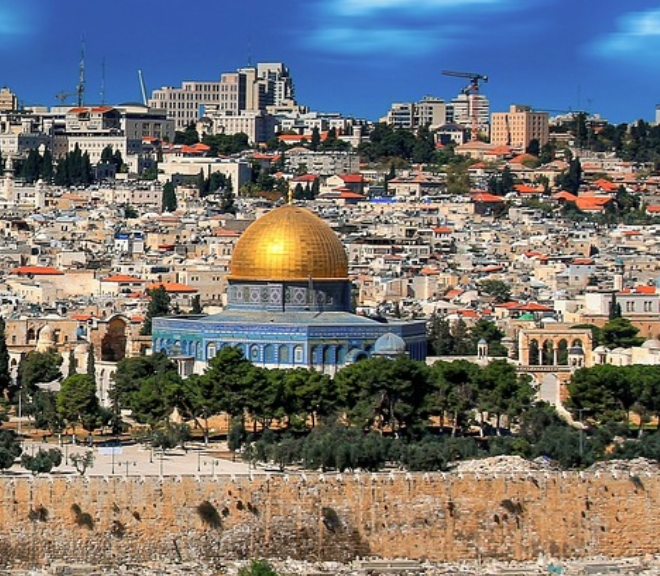The Problem With Myths Surrounding Jerusalem

My wife and I just returned from a trip to the Holy Land. The tour of Jerusalem was most informative.
It began on the Mount of Olives where you look across at the Old City of Jerusalem nestled among the Judean mountains. The history of ancient Israel was right before me. The Temple Mount, the site of the First and Second Temple, jumps out at you primarily due to the prominence of the Dome of the Rock, a Muslim site, which is located in the middle of it.
To the left of the Temple Mount was the Old City of David. I could picture Herod’s palace sitting on top of the steep slope along with the mansions of wealthy Jews, Sadducees, who were employed as priests in the Temple. Well below that posh neighborhood and further to the left was where craftsmen lived with their families. There were separate lanes for potters, cobblers, and blacksmiths in the first century. Not far from this neighborhood was the Synagogue of Freedmen whose members opposed Stephen (see chapter 6 in the Book of Acts) and where Pharisees may have gathered during the time of Jesus. A ten-minute walk from the synagogue was the city dump where the homeless took up residence. This magnificent picture gave me goosebumps.
Our actual visit within the Old City was not so impressive. It began at the Wailing Wall, the small section of the ancient Temple wall that survived the Roman destruction of the city in 70 CE. It is called the Wailing Wall because that area of the Old City was controlled by Jordan until Israel recaptured it in the 1967 war. During the period of Jordanian occupation (1948-1967), Jews could only view this sacred site from a distance. It was interesting watching Jews standing in prayer alongside the ancient wall.
From the Wailing Wall, we entered the Temple Mount and visited the sites where God formed Adam from the dust of the ground and where Abraham prepared to sacrifice Isaac. I wondered where the site of Eve’s first sin was located which gave birth to the toxic myth of original sin, but I was a good boy and never asked our guide that question. I also remained silent when our guide told us that it was within the sacred grounds of the Temple Mount where God declared Jerusalem to be the eternal capital of Israel. I was wondering, however, why God had been so slow in delivering on this promise. From the end of Solomon’s rule in the tenth century BCE until 1967, close to 3,000 years, Israel has controlled an undivided Jerusalem for less than two hundred years.
We next were led around the Dome of the Rock and then over to the al-Aqsa Mosque, the third holiest sites in the Muslim world. While we were not allowed to enter either site, we learned all about them. Muslims refer to the Temple Mount as Haram esh-Sharif or The Noble Sanctuary.
According to Muslim tradition, Muhammad hopped on a winged mule in Mecca which flew him to Jerusalem. He is believed to have landed on the spot marked by the Dome of the Rock. From there he took off again and flew to heaven with the angel Gabriel where he met God and several Old Testament prophets. When these meetings were concluded, he flew home to Mecca. While some Muslim scholars argue that this was a spiritual journey, a vision experience, Haram esh-Sharif is seen as sacred ground nevertheless.
Our nest stop was the Church of the Holy Sepulchre. This beautiful Orthodox church has several chapels, one of which marks the site where Jesus was crucified and another where he was buried and from where the resurrection took place. Again, I held my tongue as our guide explained how these two chapels confirmed some of the facts laid out in the Passion Narrative.
While historians and biblical scholars debate the historicity with regard to the biblical accounts of Jesus’s death and resurrection, few historians disagree over Roman policy concerning crucifixions. Killing fields were set up outside of a city with crosses already in place. These fields were surrounded by Roman troops whose mission was to prevent family members from removing a dead body from a cross for burial. These bodies were left for animals to devour. The policy was designed to make crucifixions so horrible that they would serve as a deterrent for potential political troublemakers. This policy made it likely that Jesus was crucified outside of the city without burial.
During the three hours we spent in the Old City, I heard lots of nice stories—myths about God forming Adam, about God declaring Jerusalem as Israel’s eternal capital, about Muhammad flying to heaven, and about Jesus’s crucifixion and burial. The problem with these nice stories is that people fight over them.
